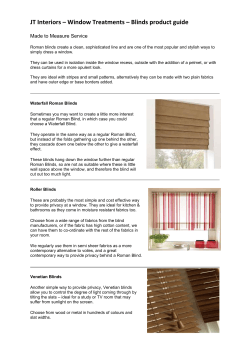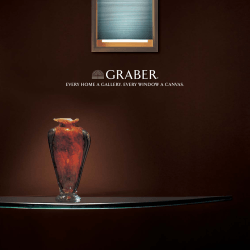
Mini Blinds How to Choose and Order the Right Window Treatments (Horizontal Blinds)
® WALLPAPER AND MORE How to Choose and Order the Right Window Treatments Mini Blinds (Horizontal Blinds) Mini Blinds use 1” horizontal slats to cover the window. You can open them by tilting the slats, or you can raise the slats up to the top of the window entirely. Normally made from aluminum, selected styles may also be available in vinyl. There are two other types of Mini Blinds: Micro Blinds have 1/2” slats and Macro Blinds have 2” slats. The slats of mini blinds (and wood blinds) are held together by the braided ladder, which runs through rout holes in each slat. Some models offer the room darkening feature, in which the rout holes are hidden, allowing less light to pass through when the blind is closed. Most 2” blinds also offer optional tapes in lieu of the braided ladder. Some manufacturers offer duotone slats. These colors are marked “duo”, “tiltone”, “duplex” or “two-tone” on our site, depending on the manufacturer. Pinlight and sheerview slats are also available in some colors and are marked “pinlt” and “shrvw”. Mini blinds are durable and require only occasional dusting, making them perfect for high-traffic areas of your home. Slats are completely opaque but can be tilted open, providing a wide range of light control. Mini blinds are also generally the most economical model of blind available. Wood Blinds These blinds are identical to mini blinds except that they are made of wood or vinyl faux wood. This causes the slats to be considerably thicker and heavier, which in turn contributes to a larger stack size. While many blinds are made of warp-resistant basswood, faux wood is still recommended for damp areas of the house such as kitchens and bathrooms. See also mini blind. Venetian Blinds Alternative term for any horizontal blind. See also mini blind. Vertical Blinds This blind has two main parts, the headrail and the vanes. The vanes attach to the headrail via a small pin and hang lengthwise over your window. The vanes can be retracted to the far left or right of the blind, or they can swivel on the pins according to the amount of light desired. Vertical blinds are made of PVC (vinyl), fabric, or occasionally aluminum. Fabric vanes are not rigid like PVC or aluminum but can be inserted into groovers. Vanes come in hundreds of textures as well as colors. PVC vertical blinds are perhaps the easiest window treatment available to care for. Because they hang vertically instead of horizontally, even dust buildup is minimal. After mini blinds, vertical blinds are the most affordable window treatments on the market. Cellular Shades/ Honeycomb Shades Cellular Shades have multiple layers of fabric bonded together to form honeycomb-shaped cells. Also known as honeycomb or duette shades, they trap air within their cells to provide insulation. They come in single-cell, double-cell, and triple-cell models. The shade can be raised to the headrail to allow full view of the window. Most cellular shades are white on one side and colored on the other. This allows for a consistent appearance to viewers outside the house while allowing you to match your shades to the the decor of each individual room. If you are looking for a cellular shade offering the same color on both the front and back of the shade, try the following products: • Bali® DiamondCell™ Double Cell Tinted Whites Collection • Graber® Crystal Pleat™ Double Cell Facets-Tinted Whites Collection Many cellular shade models offer the popular top down/bottom up feature. Pleated Shades One piece of fabric makes up the body of these shades. Pleated (folded accordion style) from top to bottom, it can be raised to the headrail to allow full view of the window. Fabrics offer a wide variety of light control, and a liner can be added for additional privacy. Many pleated shade models offer the popular top down/ bottom up feature. Most also offer a selection of privacy and blackout liners to help better control light filtering and also to provide a neutral color to be viewed from the street. Window Shadings Window shades work like mini blinds; they tilt open to allow light and tilt closed to diffuse it. They raise and lower like shades yet allow for as much privacy or view as desired. The secret is in the soft fabric vanes suspended between sheer knitted facings. When open, the vanes practically disappear, leaving your room with a beautiful, diffused glow. Window shades are also known as soft horizontals. Sometimes referred to as Horizontal Window Shadings. Roller Shades These shades hang flat over your window and are retracted by means of a roller at the window’s top. The basic shade has a straight bottom hem, but a selection of decorative hems is also available. Roller shades are available with regular and reverse rolls. Roman Shades Roman shades come in two general designs: flat and teardrop, also known as hobbled. Flat shades hang smooth while teardrop shades hang in rows of looped fabric. Both raise by bunching up the bottom tier first and continuing upward row by row. Woven Wood Shades Woven wood shades are comprised of many thin horizontal slats held in place by a variety of stitched patterns. These shades can be retracted in one of two ways. Some shades roll up much like a roller shade. Others, known as flat-folded, draw up like roman shades. Some woven wood models offer the popular top down/bottom up feature. Sheer Verticals This new collection combines sheer fabric with vertical vanes to create a wonderful alternative to draperies. When closed, this shade offers the same amount of light-blocking available from a traditional vertical blind, but when the vanes are rotated open the room is bathed in a beautiful, translucent glow without sacrificing privacy. Sheer verticals are also known as soft verticals. Sometimes referred to as Vertical Window Shadings. Shutters Shutters are an elegant way to add warmth and sophistication to any home. High quality, kiln dried wood alleviates warping, tongue and groove joints add strength and durability, special tension springs keep louvers in position, and double doweling and glue at each corner insures stability. The 2 1/2” louvers will stand up to years and years of wear. Multiple Blinds on 1 Headrail This specialty is commonly called “2 on 1 Headrail” or “3 on 1 Headrail”. An easy definition is 2 or 3 blinds with separate controls on a single headrail that equals the total width of the 2 or 3 blinds. Some manufacturers recommend or sometimes require that blinds 72” or greater in width, be made as “2 on 1 Headrail” or “3 on 1 Headrail”. Smaller blind widths may be made as “multiple blinds on 1 headrail” at the customer’s request. The advantages of having this method are: you can raise or lower each individual blind separately, and you avoid the wear and tear that a single, heavier blind would put on the lifting mechanism. NOTE: This option is available on most horizontal applications.(mini blinds, wood blinds, cellular & pleated shades, etc. It is not available on vertical blinds.) ® WALLPAPER AND MORE 1-877-533-9283 • americanblinds.com
© Copyright 2025














